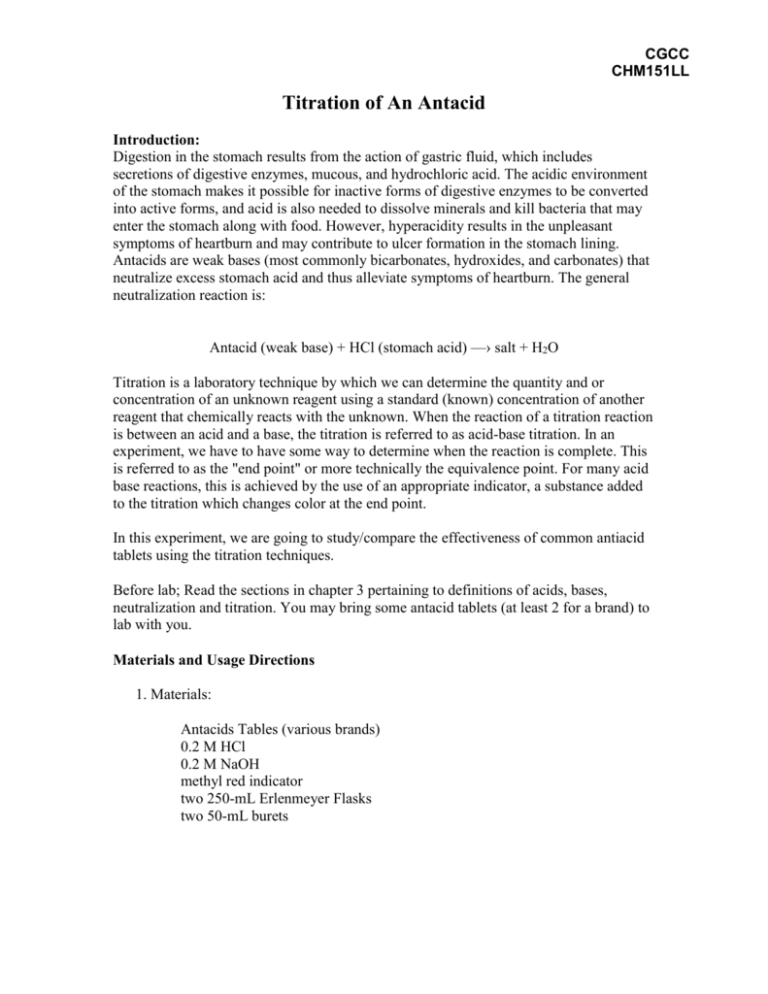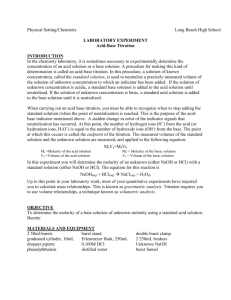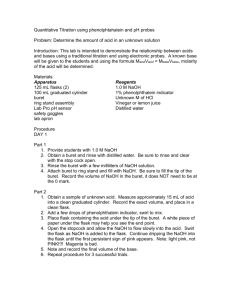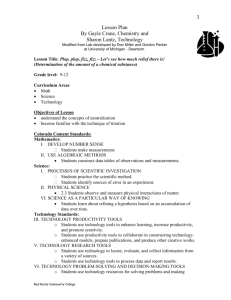CHM 151LL: Experiment #5 – Titration of An Antacid
advertisement

CGCC CHM151LL Titration of An Antacid Introduction: Digestion in the stomach results from the action of gastric fluid, which includes secretions of digestive enzymes, mucous, and hydrochloric acid. The acidic environment of the stomach makes it possible for inactive forms of digestive enzymes to be converted into active forms, and acid is also needed to dissolve minerals and kill bacteria that may enter the stomach along with food. However, hyperacidity results in the unpleasant symptoms of heartburn and may contribute to ulcer formation in the stomach lining. Antacids are weak bases (most commonly bicarbonates, hydroxides, and carbonates) that neutralize excess stomach acid and thus alleviate symptoms of heartburn. The general neutralization reaction is: Antacid (weak base) + HCl (stomach acid) —› salt + H2O Titration is a laboratory technique by which we can determine the quantity and or concentration of an unknown reagent using a standard (known) concentration of another reagent that chemically reacts with the unknown. When the reaction of a titration reaction is between an acid and a base, the titration is referred to as acid-base titration. In an experiment, we have to have some way to determine when the reaction is complete. This is referred to as the "end point" or more technically the equivalence point. For many acid base reactions, this is achieved by the use of an appropriate indicator, a substance added to the titration which changes color at the end point. In this experiment, we are going to study/compare the effectiveness of common antiacid tablets using the titration techniques. Before lab; Read the sections in chapter 3 pertaining to definitions of acids, bases, neutralization and titration. You may bring some antacid tablets (at least 2 for a brand) to lab with you. Materials and Usage Directions 1. Materials: Antacids Tables (various brands) 0.2 M HCl 0.2 M NaOH methyl red indicator two 250-mL Erlenmeyer Flasks two 50-mL burets 2. Buret Use and Titration Technique: Typically, a special piece of glassware is used to measure out one or both of the solutions used in a titration. It is called a buret, and quickly and accurately measures the volume of the solutions delivered. A diagram of a buret, and instructions on how to use it are given below. Before use, the buret must be rinsed with the solution it is to contain. Close the stopcock and use a small beaker to pour about 10 mL of solution into the buret. Tip the buret sideways and rotate it until all of the inside surfaces are coated with solution. Then open the stopcock and allow the remaining solution to run out. Again close the stopcock, and pour enough solution into the buret to fill it above the "0" mark. With the buret clamped in a vertical position, open the stopcock and allow the liquid level to drop to "0" or below. Check the buret tip. It should not contain air bubbles! If it does, see your instructor. Adjust the buret so that the liquid surface is at eye level, and take the initial buret reading as shown below: After the buret is filled, and the initial reading taken, the solution from the buret is added to the solution to be titrated (which is normally in an Erlenmeyer flask). The solution in the flask also contains an indicator, which will change color when neutralization has occurred. At first, the solution from the buret is added rapidly and the flask swirled to mix the solutions. As the endpoint is approached (or you think it is being approached), the stopcock is partially closed to slow down the addition. If the flask is not swirled during the addition of a few drops, the portion of solution surrounding the incoming drops will change color if the endpoint is near. If this happens, slow down the solution addition, and swirl the flask gently until the entire contents turn color. For accurate work, rinse down the inside surface of the flask with a stream of distilled. water near the endpoint. Half-drops of solution may be added by touching the side of the flask to the buret and rinsing down the flask. 2 Procedure Overview: A. Dissolving the antacid tablet. Since some brands of tablet do not dissolve in water, you will use a measured amount of "stomach acid" (actually about 0.2 M HCl) to dissolve the tablet. You will use more of this acid than can possibly be neutralized by the tablet, resulting in a mixture containing excess acid. B. Neutralizing the excess acid. You will add base to the above mixture and measure the amount of base required to finish neutralizing the excess acid. The more base required in this step, the less effective was the antacid tablet at stomach acid neutralization. Detailed Procedure: A. Dissolving the antacid tablet. 1. Ground one antacid tablets with Porcelain Mortars & Pestles. Transfer all the grounded antacids into a weighed 250-mL flask. (If tablet is of extra strength, transfer half the amount.) Weigh the flask with the antacid and calculate the antacid weight. 2. Fill one 50 mL buret of them with 0.2 M HCl (Do follow the directions for buret use above first). 3. After recording the initial volume, allow approx. 45 mL of HCl to run into your 250 mL Erlenmeyer flask containing the grounded antacid. Do not allow the liquid level to drop below the 50 mL mark. Leave the solution in the buret! 4. Set the flask on a wire gauze supported by a ring, and heat until the solution boils. Continue boiling the solution for 5 minutes to remove any CO2 gas that may be liberated from carbonates in the antacid. Cool the flask. B. Neutralizing the excess acid. 5. Fill a second buret with 0.2 M NaOH. Record the initial volume. 6. Add 5 drops methyl red indicator to the solution in the flask, and titrate it with the NaOH solution. Methy red is yellow if it is dissolved in a basic solution, and red in an acidic one. As the excess stomach acid is neutralized by the NaOH, the solution changes from red to yellow; the exact neutralization point is orange. If you add too much NaOH solution, you can add slightly more HCl from the first buret, and continue with NaOH addition until the endpoint is reached. 7. Read the final volumes on both burets. Repeat steps 1~7 one more time. 3











